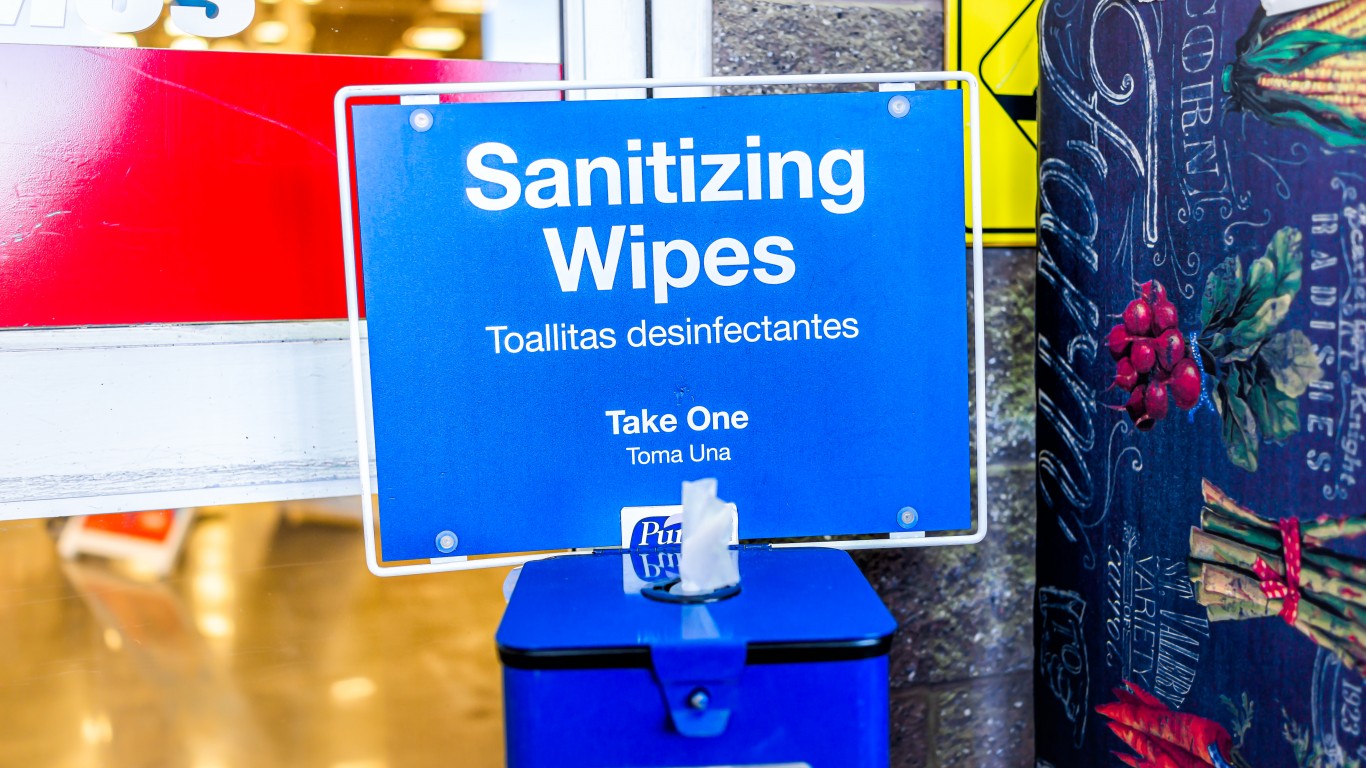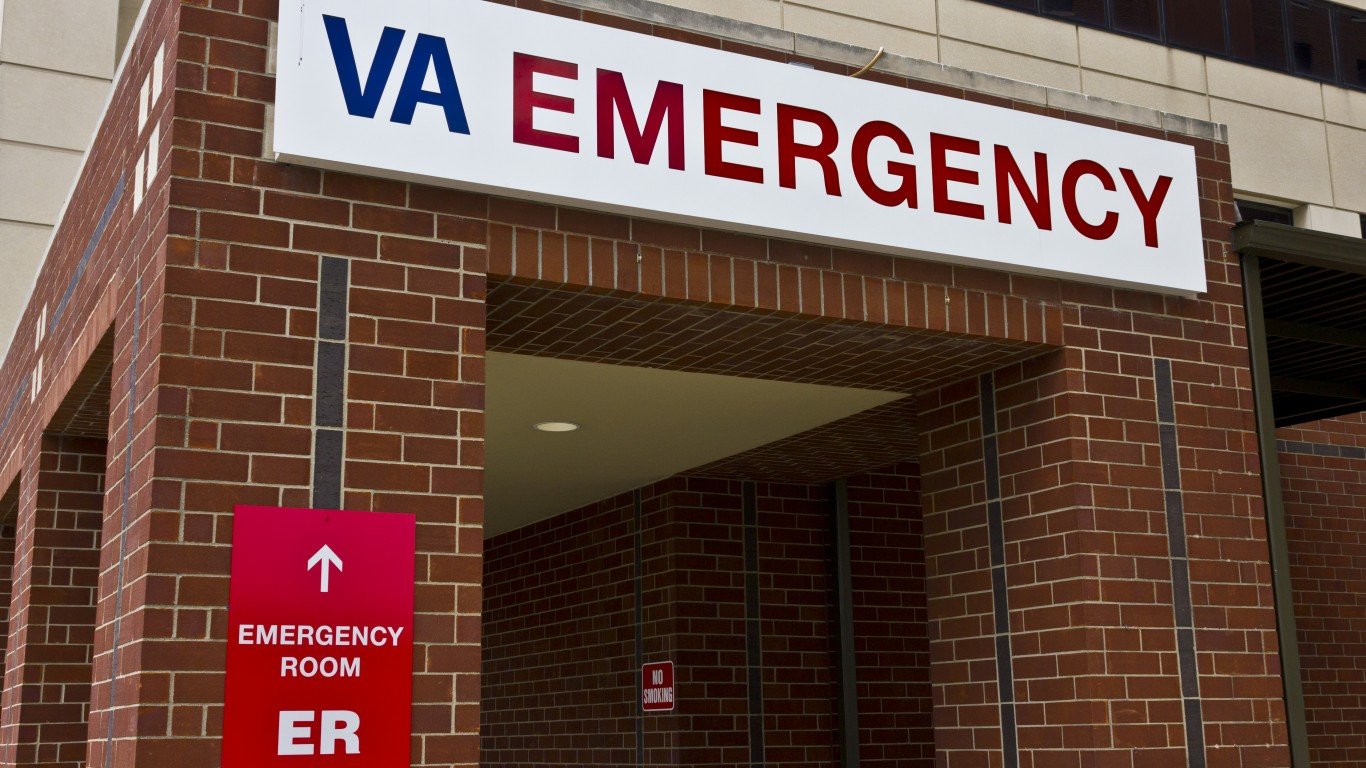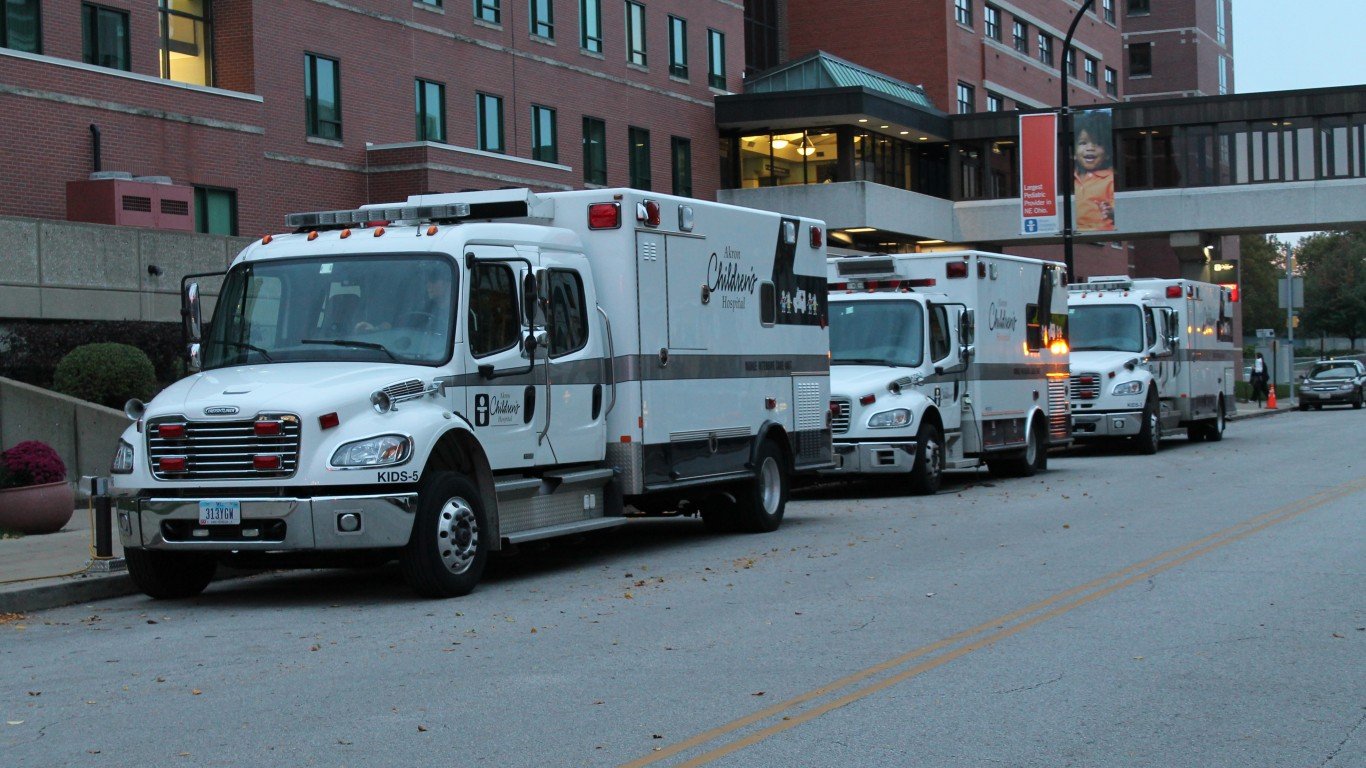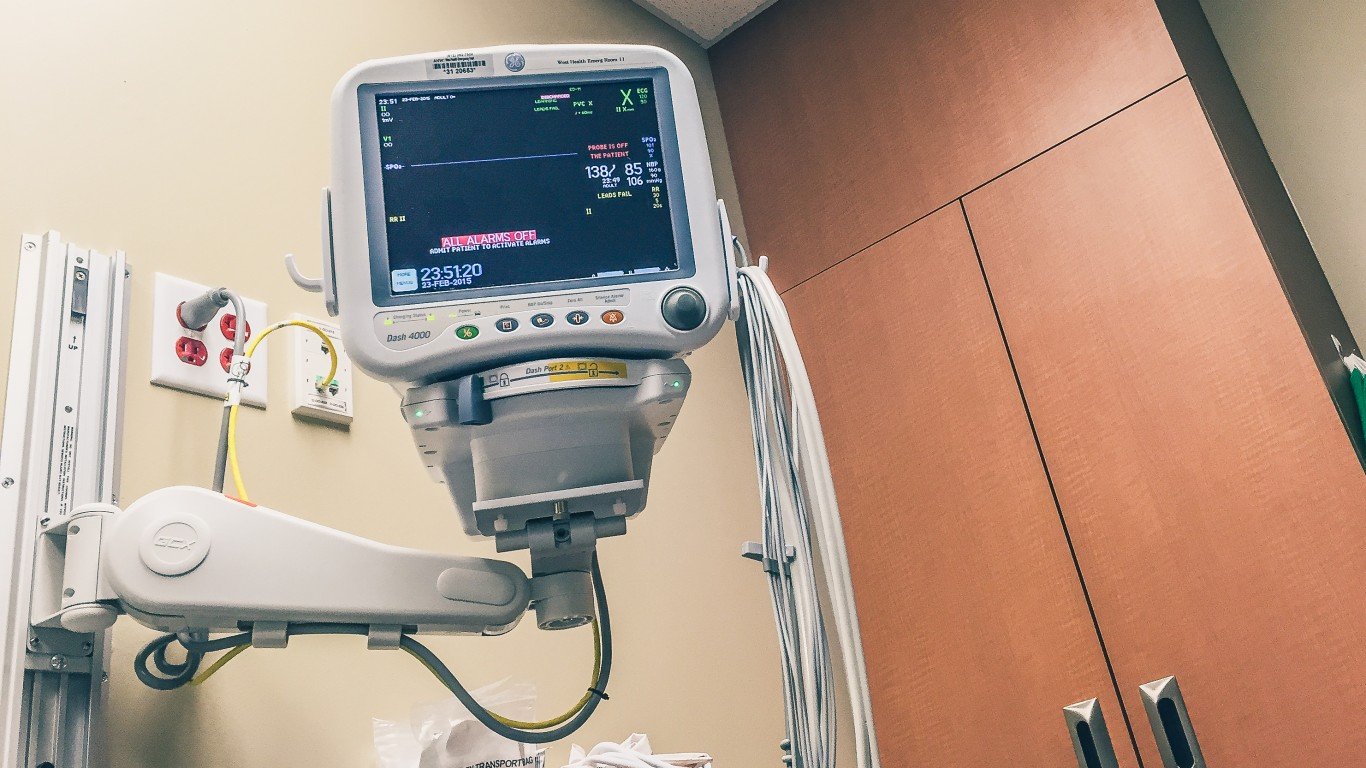

The surge of COVID-19 patients and deaths has overwhelmed hospitals all over the country. On a daily basis doctors and nurses are working on the front lines of what is being described as a medical war zone. For people without health insurance, hospitals provide some sense of security as they are legally required to admit a patient in emergency situations.
24/7 Tempo reviewed data from the Centers for Medicare & Medicaid Services and population figures from the U.S. Census Bureau to find the number of hospitals per capita in U.S. counties. On average nationwide, there is one hospital for every 63,500 people.
There were more than 6,000 hospitals and 924,000 staffed beds registered in the United States as of 2018, the latest year for which data is available, according to the American Hospital Association. Of those hospitals, 5,339 are registered with Medicare. In normal circumstances, this is enough. But these are not normal times.
As of March 31, according to the Johns Hopkins University, which is tracking reports and confirming them with local health departments, there were 164,719 confirmed cases of COVID-19 in the United States — more than any other country in the world — and the numbers are rapidly rising, in part because testing becomes more readily available.
People who are sick are not spread evenly across the country. Most cases are found in more densely-populated urban areas — and these crowded places tend to also be the counties with fewest hospitals per capita.
For example, King County, Washington, ranks towards the bottom of all U.S. counties in hospitals per capita. It has the 11th largest number of hospitals in absolute terms nationwide, at 21, but it is also the nation’s 12th most populous county, which significantly lowers its per capita ranking. King County — of which Seattle, the state’s most populous city, is part — also has one of the highest numbers of both confirmed coronavirus cases and deaths.
COVID-19 is a new disease, and everyone in the world is at risk of getting infected. According to the CDC, older adults and people of any age with pre-existing medical conditions are at higher risk of developing serious illness from the coronavirus. Here are 16 tips to prevent coronavirus and other viral infections.
Health experts are expecting COVID-19 cases to surge even more in the coming weeks, and with them there will be a surge in the more severe cases that require hospitalization. Already many hospitals are operating at capacity, and those that have not already reached their maximum capacity likely soon will.
Click here for the counties with fewest hospitals in the US.
Click here for our methodology.
50. Hampshire, Massachusetts
> Population : hospitals: 161,159 : 1
> Ambulatory surgery centers: 1
> Primary care physician to population ratio: 1 doctor per 719 people
> Pop. in 2017 reporting poor or fair health: 12.3%
> Pop. in 2018 without health insurance: 2.4%
> COVID-19 confirmed cases: 46 as of March 28, 2020
> COVID-19 related deaths: No reports as of March 28, 2020
> Most populous place in county: Northampton (population: 28,568)
[in-text-ad]

49. Chittenden, Vermont
> Population : hospitals: 162,052 : 1
> Ambulatory surgery centers: 1
> Primary care physician to population ratio: 1 doctor per 554 people
> Pop. in 2017 reporting poor or fair health: 9.9%
> Pop. in 2018 without health insurance: 3.3%
> COVID-19 confirmed cases: 133 as of March 30, 2020
> COVID-19 related deaths: No reports as of March 30, 2020
> Most populous place in county: Burlington (population: 42,513)
48. Portage, Ohio
> Population : hospitals: 162,644 : 1
> Ambulatory surgery centers: 3
> Primary care physician to population ratio: 1 doctor per 2,459 people
> Pop. in 2017 reporting poor or fair health: 15.8%
> Pop. in 2018 without health insurance: 5.8%
> COVID-19 confirmed cases: 27 as of March 30, 2020
> COVID-19 related deaths: 0 as of March 30, 2020
> Most populous place in county: Kent (population: 29,824)
47. Kent, Rhode Island
> Population : hospitals: 163,861 : 1
> Ambulatory surgery centers: 4
> Primary care physician to population ratio: 1 doctor per 1,161 people
> Pop. in 2017 reporting poor or fair health: 14.3%
> Pop. in 2018 without health insurance: 3.7%
> COVID-19 confirmed cases: 7 as of March 22, 2020
> COVID-19 related deaths: No reports as of March 22, 2020
> Most populous place in county: Warwick (population: 81,079)
[in-text-ad-2]
46. Somerset, New Jersey
> Population : hospitals: 330,176 : 2
> Ambulatory surgery centers: 8
> Primary care physician to population ratio: 1 doctor per 862 people
> Pop. in 2017 reporting poor or fair health: 12.2%
> Pop. in 2018 without health insurance: 5.3%
> COVID-19 confirmed cases: 349 as of March 31, 2020
> COVID-19 related deaths: 11 as of March 31, 2020
> Most populous place in county: Somerset (population: 24,527)
45. Cumberland, North Carolina
> Population : hospitals: 332,106 : 2
> Ambulatory surgery centers: 4
> Primary care physician to population ratio: 1 doctor per 1,330 people
> Pop. in 2017 reporting poor or fair health: 19.5%
> Pop. in 2018 without health insurance: 10.2%
> COVID-19 confirmed cases: 18 as of March 31, 2020
> COVID-19 related deaths: 0 as of March 31, 2020
> Most populous place in county: Fayetteville (population: 209,867)
[in-text-ad]

44. Beaver, Pennsylvania
> Population : hospitals: 166,896 : 1
> Ambulatory surgery centers: 1
> Primary care physician to population ratio: 1 doctor per 2,340 people
> Pop. in 2017 reporting poor or fair health: 15.0%
> Pop. in 2018 without health insurance: 4.4%
> COVID-19 confirmed cases: 44 as of March 31, 2020
> COVID-19 related deaths: 0 as of March 31, 2020
> Most populous place in county: Aliquippa (population: 9,066)

43. Aiken, South Carolina
> Population : hospitals: 166,926 : 1
> Ambulatory surgery centers: 3
> Primary care physician to population ratio: 1 doctor per 3,003 people
> Pop. in 2017 reporting poor or fair health: 17.7%
> Pop. in 2018 without health insurance: 11.3%
> COVID-19 confirmed cases: 4 as of March 30, 2020
> COVID-19 related deaths: 0 as of March 30, 2020
> Most populous place in county: Aiken (population: 30,464)

42. Chesterfield, Virginia
> Population : hospitals: 339,447 : 2
> Ambulatory surgery centers: 5
> Primary care physician to population ratio: 1 doctor per 1,142 people
> Pop. in 2017 reporting poor or fair health: 13.0%
> Pop. in 2018 without health insurance: 7.6%
> COVID-19 confirmed cases: 21 as of March 31, 2020
> COVID-19 related deaths: No reports as of March 31, 2020
> Most populous place in county: Richmond (population: 223,787)
[in-text-ad-2]

41. Licking, Ohio
> Population : hospitals: 172,293 : 1
> Ambulatory surgery centers: 1
> Primary care physician to population ratio: 1 doctor per 2,282 people
> Pop. in 2017 reporting poor or fair health: 16.1%
> Pop. in 2018 without health insurance: 6.4%
> COVID-19 confirmed cases: 15 as of March 30, 2020
> COVID-19 related deaths: 0 as of March 30, 2020
> Most populous place in county: Newark (population: 49,070)

40. Muskegon, Michigan
> Population : hospitals: 173,043 : 1
> Ambulatory surgery centers: 2
> Primary care physician to population ratio: 1 doctor per 1,639 people
> Pop. in 2017 reporting poor or fair health: 16.1%
> Pop. in 2018 without health insurance: 5.3%
> COVID-19 confirmed cases: 18 as of March 31, 2020
> COVID-19 related deaths: 2 as of March 31, 2020
> Most populous place in county: Muskegon (population: 37,969)
[in-text-ad]
39. Anoka, Minnesota
> Population : hospitals: 347,431 : 2
> Ambulatory surgery centers: 4
> Primary care physician to population ratio: 1 doctor per 1,952 people
> Pop. in 2017 reporting poor or fair health: 11.9%
> Pop. in 2018 without health insurance: 4.1%
> COVID-19 confirmed cases: 22 as of March 31, 2020
> COVID-19 related deaths: No reports as of March 31, 2020
> Most populous place in county: Minneapolis (population: 416,021)

38. Wake, North Carolina
> Population : hospitals: 1,046,558 : 6
> Ambulatory surgery centers: 13
> Primary care physician to population ratio: 1 doctor per 1,181 people
> Pop. in 2017 reporting poor or fair health: 13.4%
> Pop. in 2018 without health insurance: 8.9%
> COVID-19 confirmed cases: 186 as of March 31, 2020
> COVID-19 related deaths: 0 as of March 31, 2020
> Most populous place in county: Raleigh (population: 457,159)

37. Pitt, North Carolina
> Population : hospitals: 177,372 : 1
> Ambulatory surgery centers: 0
> Primary care physician to population ratio: 1 doctor per 942 people
> Pop. in 2017 reporting poor or fair health: 18.4%
> Pop. in 2018 without health insurance: 10.9%
> COVID-19 confirmed cases: 27 as of March 31, 2020
> COVID-19 related deaths: 0 as of March 31, 2020
> Most populous place in county: Greenville (population: 91,207)
[in-text-ad-2]

36. Butler, Pennsylvania
> Population : hospitals: 186,566 : 1
> Ambulatory surgery centers: 2
> Primary care physician to population ratio: 1 doctor per 1,509 people
> Pop. in 2017 reporting poor or fair health: 13.6%
> Pop. in 2018 without health insurance: 3.5%
> COVID-19 confirmed cases: 49 as of March 31, 2020
> COVID-19 related deaths: 2 as of March 31, 2020
> Most populous place in county: Butler (population: 13,182)

35. Orange, Florida
> Population : hospitals: 1,321,194 : 7
> Ambulatory surgery centers: 20
> Primary care physician to population ratio: 1 doctor per 1,144 people
> Pop. in 2017 reporting poor or fair health: 19.5%
> Pop. in 2018 without health insurance: 14.5%
> COVID-19 confirmed cases: 300 as of March 31, 2020
> COVID-19 related deaths: 4 as of March 31, 2020
> Most populous place in county: Orlando (population: 275,690)
[in-text-ad]

34. Johnston, North Carolina
> Population : hospitals: 191,172 : 1
> Ambulatory surgery centers: 0
> Primary care physician to population ratio: 1 doctor per 3,577 people
> Pop. in 2017 reporting poor or fair health: 16.7%
> Pop. in 2018 without health insurance: 12.2%
> COVID-19 confirmed cases: 14 as of March 31, 2020
> COVID-19 related deaths: 1 as of March 31, 2020
> Most populous place in county: Clayton (population: 20,324)

33. Loudoun, Virginia
> Population : hospitals: 385,143 : 2
> Ambulatory surgery centers: 1
> Primary care physician to population ratio: 1 doctor per 1,292 people
> Pop. in 2017 reporting poor or fair health: 11.1%
> Pop. in 2018 without health insurance: 6.2%
> COVID-19 confirmed cases: 61 as of March 31, 2020
> COVID-19 related deaths: No reports as of March 31, 2020
> Most populous place in county: Leesburg (population: 52,125)

32. Hall, Georgia
> Population : hospitals: 195,961 : 1
> Ambulatory surgery centers: 15
> Primary care physician to population ratio: 1 doctor per 1,846 people
> Pop. in 2017 reporting poor or fair health: 18.3%
> Pop. in 2018 without health insurance: 17.4%
> COVID-19 confirmed cases: 34 as of March 31, 2020
> COVID-19 related deaths: 0 as of March 31, 2020
> Most populous place in county: Gainesville (population: 38,624)
[in-text-ad-2]

31. Delaware, Ohio
> Population : hospitals: 197,008 : 1
> Ambulatory surgery centers: 12
> Primary care physician to population ratio: 1 doctor per 701 people
> Pop. in 2017 reporting poor or fair health: 12.6%
> Pop. in 2018 without health insurance: 3.9%
> COVID-19 confirmed cases: 31 as of March 30, 2020
> COVID-19 related deaths: 0 as of March 30, 2020
> Most populous place in county: Columbus (population: 867, 628)

30. Kings, New York
> Population : hospitals: 2,600,747 : 13
> Ambulatory surgery centers: 14
> Primary care physician to population ratio: 1 doctor per 1,554 people
> Pop. in 2017 reporting poor or fair health: 18.1%
> Pop. in 2018 without health insurance: 8.2%
> COVID-19 confirmed cases: 37,453 in all of NYC as of March 31, 2020
> COVID-19 related deaths: 914 in all of NYC as of March 31, 2020
[in-text-ad]

29. Cabarrus, North Carolina
> Population : hospitals: 201,448 : 1
> Ambulatory surgery centers: 8
> Primary care physician to population ratio: 1 doctor per 1,149 people
> Pop. in 2017 reporting poor or fair health: 14.7%
> Pop. in 2018 without health insurance: 7.8%
> COVID-19 confirmed cases: 47 as of March 31, 2020
> COVID-19 related deaths: 1 as of March 31, 2020
> Most populous place in county: Concord (population: 89, 729)

28. Clermont, Ohio
> Population : hospitals: 203,216 : 1
> Ambulatory surgery centers: 2
> Primary care physician to population ratio: 1 doctor per 1,524 people
> Pop. in 2017 reporting poor or fair health: 15.1%
> Pop. in 2018 without health insurance: 5.7%
> COVID-19 confirmed cases: 8 as of March 30, 2020
> COVID-19 related deaths: 0 as of March 30, 2020
> Most populous place in county: Cincinnati (population: 300,357)

27. Bronx, New York
> Population : hospitals: 1,437,872 : 7
> Ambulatory surgery centers: 8
> Primary care physician to population ratio: 1 doctor per 1,768 people
> Pop. in 2017 reporting poor or fair health: 26.8%
> Pop. in 2018 without health insurance: 9.7%
> COVID-19 confirmed cases: 37,453 in all of NYC as of March 31, 2020
> COVID-19 related deaths: 914 in all of NYC as of March 31, 2020
[in-text-ad-2]
26. Yuma, Arizona
> Population : hospitals: 207,829 : 1
> Ambulatory surgery centers: 4
> Primary care physician to population ratio: 1 doctor per 2,118 people
> Pop. in 2017 reporting poor or fair health: 22.7%
> Pop. in 2018 without health insurance: 13.3%
> COVID-19 confirmed cases: 5 as of March 31, 2020
> COVID-19 related deaths: No reports as of March 31, 2020
> Most populous place in county: Yuma (population: 95,573)
25. Dakota, Minnesota
> Population : hospitals: 418,201 : 2
> Ambulatory surgery centers: 5
> Primary care physician to population ratio: 1 doctor per 1,512 people
> Pop. in 2017 reporting poor or fair health: 10.0%
> Pop. in 2018 without health insurance: 3.8%
> COVID-19 confirmed cases: 46 as of March 31, 2020
> COVID-19 related deaths: No reports as of March 31, 2020
> Most populous place in county: Lakeville (population: 62,489)
[in-text-ad]

24. Shelby, Alabama
> Population : hospitals: 211,261 : 1
> Ambulatory surgery centers: 1
> Primary care physician to population ratio: 1 doctor per 1,242 people
> Pop. in 2017 reporting poor or fair health: 16.5%
> Pop. in 2018 without health insurance: 6.8%
> COVID-19 confirmed cases: 88 as of March 31, 2020
> COVID-19 related deaths: 2 as of March 31, 2020
> Most populous place in county: Birmingham (population: 212,021)

23. Gaston, North Carolina
> Population : hospitals: 216,585 : 1
> Ambulatory surgery centers: 3
> Primary care physician to population ratio: 1 doctor per 1,643 people
> Pop. in 2017 reporting poor or fair health: 18.1%
> Pop. in 2018 without health insurance: 10.8%
> COVID-19 confirmed cases: 27 as of March 31, 2020
> COVID-19 related deaths: 0 as of March 31, 2020
> Most populous place in county: Gastonia (population: 75,138)

22. Whatcom, Washington
> Population : hospitals: 216,812 : 1
> Ambulatory surgery centers: 10
> Primary care physician to population ratio: 1 doctor per 1,096 people
> Pop. in 2017 reporting poor or fair health: 12.5%
> Pop. in 2018 without health insurance: 6.5%
> COVID-19 confirmed cases: 102 as of March 29, 2020
> COVID-19 related deaths: 4 as of March 29, 2020
> Most populous place in county: Bellingham (population: 87,071)
[in-text-ad-2]

21. Forsyth, Georgia
> Population : hospitals: 219,880 : 1
> Ambulatory surgery centers: 12
> Primary care physician to population ratio: 1 doctor per 2,561 people
> Pop. in 2017 reporting poor or fair health: 13.0%
> Pop. in 2018 without health insurance: 8.9%
> COVID-19 confirmed cases: 36 as of March 31, 2020
> COVID-19 related deaths: 1 as of March 31, 2020
> Most populous place in county: Cumming (population: 6,027)

20. Henry, Georgia
> Population : hospitals: 221,307 : 1
> Ambulatory surgery centers: 1
> Primary care physician to population ratio: 1 doctor per 2,110 people
> Pop. in 2017 reporting poor or fair health: 17.2%
> Pop. in 2018 without health insurance: 11.0%
> COVID-19 confirmed cases: 68 as of March 31, 2020
> COVID-19 related deaths: 2 as of March 31, 2020
> Most populous place in county: Stockbridge (population: 28,648)
[in-text-ad]
19. Gwinnett, Georgia
> Population : hospitals: 902,298 : 4
> Ambulatory surgery centers: 16
> Primary care physician to population ratio: 1 doctor per 1,584 people
> Pop. in 2017 reporting poor or fair health: 16.4%
> Pop. in 2018 without health insurance: 17.0%
> COVID-19 confirmed cases: 178 as of March 31, 2020
> COVID-19 related deaths: 2 as of March 31, 2020
> Most populous place in county: Lawrenceville (population: 29,401)

18. Union, North Carolina
> Population : hospitals: 226,694 : 1
> Ambulatory surgery centers: 2
> Primary care physician to population ratio: 1 doctor per 1,522 people
> Pop. in 2017 reporting poor or fair health: 13.9%
> Pop. in 2018 without health insurance: 9.4%
> COVID-19 confirmed cases: 41 as of March 31, 2020
> COVID-19 related deaths: 0 as of March 31, 2020
> Most populous place in county: Indian Trail (population: 37,983)

17. Seminole, Florida
> Population : hospitals: 455,086 : 2
> Ambulatory surgery centers: 7
> Primary care physician to population ratio: 1 doctor per 1,322 people
> Pop. in 2017 reporting poor or fair health: 16.1%
> Pop. in 2018 without health insurance: 10.4%
> COVID-19 confirmed cases: 88 as of March 31, 2020
> COVID-19 related deaths: 0 as of March 31, 2020
> Most populous place in county: Sanford (population: 58,862)
[in-text-ad-2]

16. Prince William, Virginia
> Population : hospitals: 456,749 : 2
> Ambulatory surgery centers: 3
> Primary care physician to population ratio: 1 doctor per 2,248 people
> Pop. in 2017 reporting poor or fair health: 15.3%
> Pop. in 2018 without health insurance: 11.4%
> COVID-19 confirmed cases: 79 as of March 31, 2020
> COVID-19 related deaths: No reports as of March 31, 2020
> Most populous place in county: Manassas (population: 41,457)

15. Will, Illinois
> Population : hospitals: 688,697 : 3
> Ambulatory surgery centers: 3
> Primary care physician to population ratio: 1 doctor per 1,828 people
> Pop. in 2017 reporting poor or fair health: 14.6%
> Pop. in 2018 without health insurance: 5.6%
> COVID-19 confirmed cases: 21 as of March 31, 2020
> COVID-19 related deaths: 1 as of March 31, 2020
> Most populous place in county: Aurora (population: 200,660)
[in-text-ad]

14. Clark, Washington
> Population : hospitals: 465,384 : 2
> Ambulatory surgery centers: 7
> Primary care physician to population ratio: 1 doctor per 1,417 people
> Pop. in 2017 reporting poor or fair health: 13.7%
> Pop. in 2018 without health insurance: 6.3%
> COVID-19 confirmed cases: 82 as of March 29, 2020
> COVID-19 related deaths: 6 as of March 29, 2020
> Most populous place in county: Vancouver (population: 178,413)

13. St. Johns, Florida
> Population : hospitals: 235,503 : 1
> Ambulatory surgery centers: 6
> Primary care physician to population ratio: 1 doctor per 1,046 people
> Pop. in 2017 reporting poor or fair health: 12.7%
> Pop. in 2018 without health insurance: 8.4%
> COVID-19 confirmed cases: 61 as of March 31, 2020
> COVID-19 related deaths: 2 as of March 31, 2020
> Most populous place in county: Jacksonville (population: 878,907)

12. Cherokee, Georgia
> Population : hospitals: 241,910 : 1
> Ambulatory surgery centers: 12
> Primary care physician to population ratio: 1 doctor per 2,579 people
> Pop. in 2017 reporting poor or fair health: 14.9%
> Pop. in 2018 without health insurance: 10.9%
> COVID-19 confirmed cases: 69 as of March 30, 2020
> COVID-19 related deaths: 1 as of March 30, 2020
> Most populous place in county: Woodstock (population: 30,362)
[in-text-ad-2]

11. Cobb, Georgia
> Population : hospitals: 745,057 : 3
> Ambulatory surgery centers: 20
> Primary care physician to population ratio: 1 doctor per 1,418 people
> Pop. in 2017 reporting poor or fair health: 13.7%
> Pop. in 2018 without health insurance: 13.0%
> COVID-19 confirmed cases: 250 as of March 31, 2020
> COVID-19 related deaths: 11 as of March 31, 2020
> Most populous place in county: Atlanta (population: 479,655)

10. Frederick, Maryland
> Population : hospitals: 248,472 : 1
> Ambulatory surgery centers: 15
> Primary care physician to population ratio: 1 doctor per 1,605 people
> Pop. in 2017 reporting poor or fair health: 11.5%
> Pop. in 2018 without health insurance: 4.8%
> COVID-19 confirmed cases: 26 as of March 31, 2020
> COVID-19 related deaths: 0 as of March 31, 2020
> Most populous place in county: Frederick (population: 70,166)
[in-text-ad]
9. Passaic, New Jersey
> Population : hospitals: 504,041 : 2
> Ambulatory surgery centers: 17
> Primary care physician to population ratio: 1 doctor per 1,762 people
> Pop. in 2017 reporting poor or fair health: 24.0%
> Pop. in 2018 without health insurance: 12.4%
> COVID-19 confirmed cases: 1,091 as of March 31, 2020
> COVID-19 related deaths: No reports as of March 31, 2020
> Most populous place in county: Paterson (population: 145,800)

8. York, South Carolina
> Population : hospitals: 258,641 : 1
> Ambulatory surgery centers: 3
> Primary care physician to population ratio: 1 doctor per 2,277 people
> Pop. in 2017 reporting poor or fair health: 14.2%
> Pop. in 2018 without health insurance: 8.7%
> COVID-19 confirmed cases: 19 as of March 30, 2020
> COVID-19 related deaths: 0 as of March 30, 2020
> Most populous place in county: Rock Hill (population: 71,903)

7. Guilford, North Carolina
> Population : hospitals: 523,582 : 2
> Ambulatory surgery centers: 14
> Primary care physician to population ratio: 1 doctor per 1,258 people
> Pop. in 2017 reporting poor or fair health: 16.3%
> Pop. in 2018 without health insurance: 10.1%
> COVID-19 confirmed cases: 50 as of March 31, 2020
> COVID-19 related deaths: 0 as of March 31, 2020
> Most populous place in county: Greensboro (population: 288,719)
[in-text-ad-2]

6. Anne Arundel, Maryland
> Population : hospitals: 567,696 : 2
> Ambulatory surgery centers: 28
> Primary care physician to population ratio: 1 doctor per 1,440 people
> Pop. in 2017 reporting poor or fair health: 12.2%
> Pop. in 2018 without health insurance: 4.7%
> COVID-19 confirmed cases: 110 as of March 31, 2020
> COVID-19 related deaths: 0 as of March 31, 2020
> Most populous place in county: Baltimore (population: 614,700)

5. Gloucester, New Jersey
> Population : hospitals: 290,852 : 1
> Ambulatory surgery centers: 11
> Primary care physician to population ratio: 1 doctor per 1,849 people
> Pop. in 2017 reporting poor or fair health: 16.1%
> Pop. in 2018 without health insurance: 4.6%
> COVID-19 confirmed cases: 89 as of March 31, 2020
> COVID-19 related deaths: No reports as of March 31, 2020
> Most populous place in county: Glassboro (population: 19,580)
[in-text-ad]

4. Spartanburg, South Carolina
> Population : hospitals: 302,195 : 1
> Ambulatory surgery centers: 2
> Primary care physician to population ratio: 1 doctor per 1,461 people
> Pop. in 2017 reporting poor or fair health: 17.1%
> Pop. in 2018 without health insurance: 10.9%
> COVID-19 confirmed cases: 9 as of March 30, 2020
> COVID-19 related deaths: 0 as of March 30, 2020
> Most populous place in county: Spartanburg (population: 37,370)

3. Howard, Maryland
> Population : hospitals: 315,327 : 1
> Ambulatory surgery centers: 14
> Primary care physician to population ratio: 1 doctor per 517 people
> Pop. in 2017 reporting poor or fair health: 9.7%
> Pop. in 2018 without health insurance: 4.0%
> COVID-19 confirmed cases: 96 as of March 31, 2020
> COVID-19 related deaths: 0 as of March 31, 2020
> Most populous place in county: Columbia (population: 103,663)

2. Henrico, Virginia
> Population : hospitals: 325,642 : 1
> Ambulatory surgery centers: 4
> Primary care physician to population ratio: 1 doctor per 950 people
> Pop. in 2017 reporting poor or fair health: 14.0%
> Pop. in 2018 without health insurance: 8.3%
> COVID-19 confirmed cases: 44 as of March 31, 2020
> COVID-19 related deaths: No reports as of March 31, 2020
> Most populous place in county: Richmond (population: 223,787)
[in-text-ad-2]
1. Queens, New York
> Population : hospitals: 2,278,906 : 7
> Ambulatory surgery centers: 12
> Primary care physician to population ratio: 1 doctor per 1,608 people
> Pop. in 2017 reporting poor or fair health: 18.5%
> Pop. in 2018 without health insurance: 10.5%
> COVID-19 confirmed cases: 37,453 in all of NYC as of March 31, 2020
> COVID-19 related deaths: 914 in all of NYC as of March 31, 2020
To identify the counties with the fewest hospitals per capita, 24/7 Tempo reviewed government data for all 5,339 hospitals and ambulatory surgery centers registered with Medicare, a federal health insurance program that serves the elderly and people with disabilities.
The number of ambulatory surgery centers, which provide surgical services to patients not requiring hospitalization, also came from Medicare.
Data on total county population, share of population without health insurance, and the number of primary care physicians came from the U.S. Census Bureau’s 2018 American Community Survey and are based on 5-year estimates.
The share of each county’s population in poor and fair health and living with diabetes came from the 2020 report by County Health Rankings & Roadmaps, a Robert Wood Johnson Foundation and University of Wisconsin Population Health Institute joint program.
The numbers of confirmed COVID-19 cases and deaths are the latest available and come from the Centers for Disease Control and Prevention as well as from state and local health departments.
Essential Tips for Investing: Sponsored
A financial advisor can help you understand the advantages and disadvantages of investment properties. Finding a qualified financial advisor doesn’t have to be hard. SmartAsset’s free tool matches you with up to three financial advisors who serve your area, and you can interview your advisor matches at no cost to decide which one is right for you. If you’re ready to find an advisor who can help you achieve your financial goals, get started now.
Investing in real estate can diversify your portfolio. But expanding your horizons may add additional costs. If you’re an investor looking to minimize expenses, consider checking out online brokerages. They often offer low investment fees, helping you maximize your profit.
Thank you for reading! Have some feedback for us?
Contact the 24/7 Wall St. editorial team.





 24/7 Wall St.
24/7 Wall St.
 24/7 Wall St.
24/7 Wall St.


 24/7 Wall St.
24/7 Wall St.
 24/7 Wall St.
24/7 Wall St.


